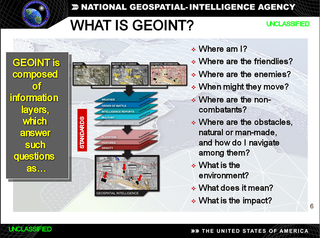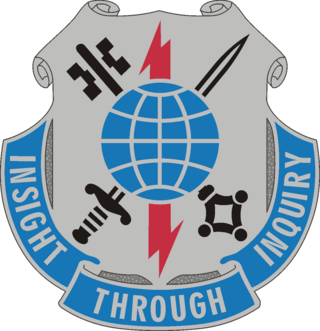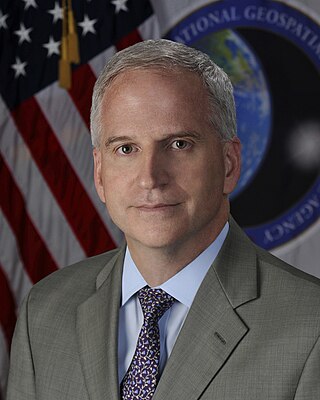
The National Geospatial-Intelligence Agency (NGA) is a combat support agency within the United States Department of Defense whose primary mission is collecting, analyzing, and distributing geospatial intelligence (GEOINT) in support of national security. Initially known as the National Imagery and Mapping Agency (NIMA) from 1996 to 2003, it is a member of the United States Intelligence Community.

ISTAR stands for intelligence, surveillance, target acquisition, and reconnaissance. In its macroscopic sense, ISTAR is a practice that links several battlefield functions together to assist a combat force in employing its sensors and managing the information they gather.

In the United States, geospatial intelligence (GEOINT) is intelligence about the human activity on earth derived from the exploitation and analysis of imagery, signals, or signatures with geospatial information. GEOINT describes, assesses, and visually depicts physical features and geographically referenced activities on the Earth. GEOINT, as defined in US Code, consists of imagery, imagery intelligence (IMINT) and geospatial information.

The 519th Military Intelligence Battalion is a unit of the United States Army.

The Delaware Army National Guard is a component of the United States Army and the United States National Guard. National coordination of various state National Guard units are maintained through the National Guard Bureau.

The 223rd Military Intelligence Battalion is a military intelligence battalion subordinate to the 300th Military Intelligence Brigade and part of the California Army National Guard.

The United States Army Intelligence and Security Command (INSCOM) is a direct reporting unit that conducts intelligence, security, and information operations for United States Army commanders, partners in the Intelligence Community, and national decision-makers. INSCOM is headquartered at Fort Belvoir, Virginia.

The 249th Engineer Battalion (United States) is a versatile power generation battalion assigned to the U.S. Army Corps of Engineers that provides commercial-level power to military units and federal relief organizations during full-spectrum operations. Additionally, the commander serves as the Commandant of the U.S. Army Prime Power School, the institution responsible for the development of Army and Navy power generation specialists.
The Army Geospatial Center (AGC) is a Major Subordinate Command of the United States Army Corps of Engineers. It is located in Alexandria, Virginia, within the Humphreys Engineering Center adjacent to the Fort Belvoir military reservation.

The 1st Brigade Combat Team, 10th Mountain Division is an active Infantry Brigade Combat Team of the United States Army based at Fort Drum in New York. The brigade headquarters carries the lineage of the 10th Mountain Division's original headquarters company, and served as such in World War II, and in peacetime at Fort Riley, Fort Benning, and West Germany in the 1940s and 1950s.

The 302nd Military Intelligence Battalion, whose unit crest portrays the "sly fox", evolved from the 3252d Signal Service Company which was activated in England on 1 April 1944.

U.S. Army Cyber Command (ARCYBER) conducts information dominance and cyberspace operations as the Army service component command of United States Cyber Command.

The 319th Military Intelligence Battalion is a military intelligence battalion in the United States Army and is part of the 525th Military Intelligence Brigade (Expeditionary).

Robert Cardillo is a Distinguished Fellow at Georgetown University’s Center for Security and Emerging Technology. Prior to this appointment, he was the sixth Director of the National Geospatial-Intelligence Agency and was sworn in October 3, 2014. He was previously selected by Director of National Intelligence James Clapper to serve as the first Deputy Director of National Intelligence for Intelligence Integration in September 2010. Clapper said in a statement that the position would "elevate information sharing and collaboration" between those who collect intelligence and those who analyze it. Cardillo previously served as deputy director of the Defense Intelligence Agency (DIA). Prior to that, he served as the deputy director for Analysis, DIA, and Director, Analysis and Production, National Geospatial-Intelligence Agency (NGA).
Geographic information systems (GIS) play a constantly evolving role in geospatial intelligence (GEOINT) and United States national security. These technologies allow a user to efficiently manage, analyze, and produce geospatial data, to combine GEOINT with other forms of intelligence collection, and to perform highly developed analysis and visual production of geospatial data. Therefore, GIS produces up-to-date and more reliable GEOINT to reduce uncertainty for a decisionmaker. Since GIS programs are Web-enabled, a user can constantly work with a decision maker to solve their GEOINT and national security related problems from anywhere in the world. There are many types of GIS software used in GEOINT and national security, such as Google Earth, ERDAS IMAGINE, GeoNetwork opensource, and Esri ArcGIS.

John Frederick "Jeff" Kimmons is a retired American lieutenant general, who served as United States Army Assistant Chief of Staff for Intelligence, Commanding General, United States Army Intelligence and Security Command and chief of staff to the Director of National Intelligence. He was instrumental in the development of Army Field Manual, FM 2-22.3, Human Intelligence Collector Operations, which was the Army's response to actions at Abu Ghraib prison. Kimmons retired from active service on December 1, 2010, after 35 years.

The 470th Military Intelligence Brigade is a unit of the United States Army and subordinate to the U.S. Army Intelligence and Security Command. Its mission is to provide tailored, multi-disciplined intelligence and counter-intelligence in support of United States Army South (ARSOUTH) and United States Southern Command (USSOUTHCOM). The 470th is headquartered at Fort Sam Houston, Texas with subordinate battalions located in Texas and Florida. Elements of the 470th have participated in Operation Just Cause and have deployed in support of Operation Iraqi Freedom and Operation Enduring Freedom.

The 525th Expeditionary Military Intelligence Brigade (Expeditionary) is a unit of the United States Army specializing in the acquisition and analysis of information with potential military value. On 28 October 2014, the unit was reflagged from the "525th Battlefield Surveillance Brigade" to an expeditionary military intelligence brigade, the first of its kind.

The 502nd Military Intelligence Battalion is a military intelligence unit of the United States Army.

The 203rd Military Intelligence Battalion (Technical Intelligence) is the sole technical intelligence (TECHINT) collection and foreign material exploitation unit of the United States Department of Defense and a battalion in the United States Army Reserve. The 203rd obtains and exploits captured enemy materials, maintains one of the premier test and evaluation inventories of adversary equipment and weaponry in the US military, and supports specialized tasking including counter-terrorism, special reconnaissance, and direct action missions. Much of the units work is conducted in close collaboration with the National Ground Intelligence Center. The battalion's intelligence products provide TECHINT support to INSCOM, the Defense Intelligence Enterprise, the broader US Intelligence Community (IC), the Five Eyes, NATO, and foreign allies and partners.





















